Climbing Mount Everest with haemophilia
Fri 11 Dec 2020
Chris Bombardier has severe haemophilia B, but that hasn't stopped him from taking on extreme adventure sport.
He joined HFA and the Australian bleeding disorders community in a Live Chat session to talk about completing the climb to the summit of Mount Everest, the highest mountain in the world, what it meant to him and why he did it.
Watch the video of the Live Chat session with Chris
Chris joined joined a panel of
Australian rock climbers with severe haemophilia and a Haemophilia Treatment Centre nurse and physiotherapist in a live chat with the Australian bleeding disorders community.
Climbing Mount Everest
Climbing Mount Everest is an amazing achievement for anyone, but for Chris Bombardier it also meant overcoming the challenges of having severe haemophilia B. In 2017 Chris partnered with film-maker Patrick James Lynch, who also has haemophilia, to make a documentary about his journey through Nepal to the top of Mount Everest in the film
Bombardier Blood. This journey was the result of a lifetime of struggle to deal with his haemophilia and to achieve his goal of climbing the Seven Summits, the highest mountains of each of the seven continents.
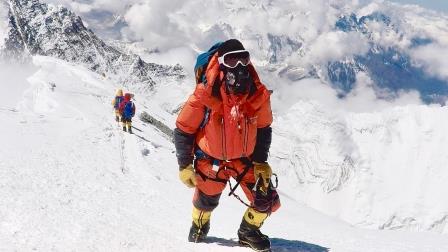 Chris taking the final steps to the summit of Mount Everest
Chris taking the final steps to the summit of Mount Everest
Photo: Chris Bombardier
Along the way he was confronted by the difficulties in getting access to haemophilia diagnosis and treatment in resource-poor countries like Nepal - and the extraordinary efforts made by people with haemophilia and their families to manage their condition and their disability and pain. The contrast with his experience of haemophilia affected Chris deeply. He is now the Executive Director of the
Save One Life foundation, which provides direct financial assistance and medical treatment to people with bleeding disorders in developing countries, particularly children and youth.
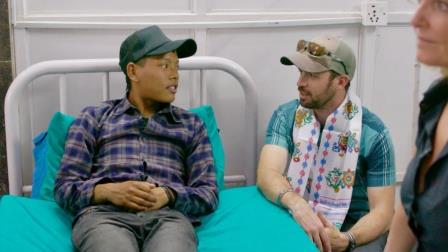 Chris at the hospital in Nepal with a young community member with haemophilia
Photo: Chris Bombardier
Chris at the hospital in Nepal with a young community member with haemophilia
Photo: Chris Bombardier
Why climbing?
Chris explained that he was a very active child and had played baseball throughout his young life. After college he was searching for something active to do and started mountain climbing with his uncle in Colorado. This involved a lot of self-awareness: the safety of all climbers in the team depended on Chris being able to manage himself and his haemophilia, to be prepared and to be clear to others beforehand when a situation would be too much for him.
There were also tricky aspects specifically related to treatment: how to carry his factor and keep it at the right temperature during the long trek to the mountain summit, how to infuse in the intense cold and teaching his walking companions about how to infuse him in an emergency.
Chris undertook the Everest summit while the international bleeding disorders community watched from afar. He made a point of taking a small flag signed by the local Nepalese haemophilia community to the top so that they could be with him in spirit and appreciated the international support – with messages from as far afield as Tasmania.
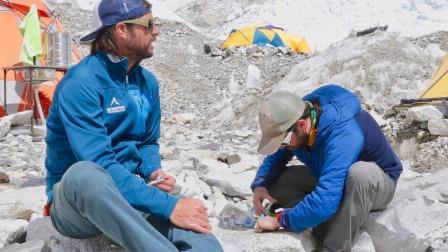 Chris infusing his factor at Mount Everest Base Camp with guide Ryan Waters
Chris infusing his factor at Mount Everest Base Camp with guide Ryan Waters
Photo: Chris Bombardier
Growing up with haemophilia
Why did he decide to start mountain climbing? Chris offered some very honest reflections about growing up with the challenges of haemophilia. When he was young, he had on demand therapy for bleeds as they occurred rather than prophylaxis treatment to prevent bleeds. He described his difficulties at school: the teasing about being on crutches, worrying about injuries at the playground and having to go to the emergency room, and feeling so different for such a long time during his life.
‘It wasn’t until after college when I got to meet with the haemophilia community that I realised that I had a story going on in my head all the time that I wasn’t good enough. I thought I was the only one facing those struggles. For me, meeting the bleeding disorders community and having that connection was a very powerful experience – to accept my bleeding disorder. To realise, yes, I have this thing that is different and a challenge for me, but there are other people who are going through it too, who can support me and who understand – who don’t think I am defective or wrong. I think this gave me the confidence to try these climbs and become an advocate for my community.’
Connecting to others
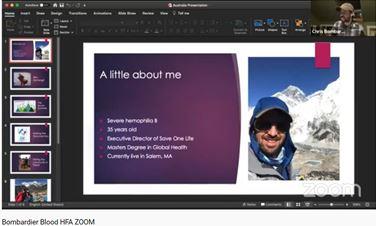
Chris explained that he would have loved to be involved with haemophilia community camps earlier in his life.
‘I didn’t really know anyone with haemophilia growing up until after college. It would have been great to have been able to talk to people who understood what bleeds were like and the frustration you feel sometimes when you want be physically active and do something but your body is just not keeping up. I didn’t have anyone to talk to about that and it was really hard. I felt very lonely. I struggled with depression for a long time.
‘I had a lot of negative perceptions of haemophilia and I didn’t really accept my bleeding disorder before I got connected with other people. I hated having haemophilia, I really resented having it. I didn’t talk about it with other people, I didn’t share, because I didn’t want them to judge me and think differently of me. Even with my baseball team at high school and college: I would tell them I had haemophilia, but really downplay it and say, it’s no big deal, I just have to do this thing every once in a while.
‘Now that I am connected with the community, I have realised it is something I shouldn’t be ashamed of. Having it is not within my control – I was just born with it – but it has helped me to realise how to overcome challenges and be more resilient. People with bleeding disorders are pretty resilient people – pretty stubborn too! It has taught me empathy and compassion for other people and that is something I am proud of now.’
Working with the HTC
The value of working with his HTC on his treatment plan makes a lot of sense to Chris now, but understanding this happened later in his life, after he came to terms with having haemophilia .
‘When I was younger there were times when I didn’t listen to my HTC about taking my prophylactic treatment and that always ended up in not a good place. Even in college, when I was supposed to take my prophylaxis before baseball games, I didn’t want to do it. I didn’t want to have to stop and infuse and feel different. And so I didn’t do it, many times, and I ended up with some of the worst bleeds I have ever had because I didn’t follow their guidance. Now we work together on my physical activities and they help me figure it out.’
Sharing what he has learned from his climbing experience has been a way for Chris to connect to the worldwide bleeding disorders community and hopefully help others to meet their personal challenges.
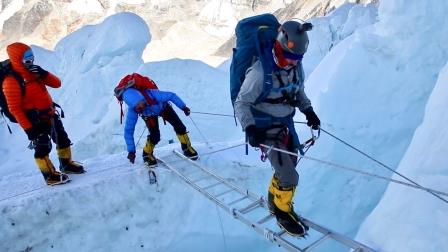 Chris walking over a terrifyingly deep crevasse on a ladder
Chris walking over a terrifyingly deep crevasse on a ladder
Photo: Chris Bombardier
Q & A
In the chat after his presentation, Chris answered questions from the online audience, including:
Who was involved in training for Chris’s climb?
- The whole Haemophilia Treatment Centre team!
- The physiotherapist was very involved in training and preparation - and rehabilitation after a serious mountain biking injury before the climb
- Chris had arranged medical and travel insurance
- Chris was on extended half-life factor treatment for Everest, which meant he didn’t have to vary his treatment schedule much, but he made sure he had a treatment before he took climbs ‘where rocks might fall on me’
- He still finds it difficult infusing into a vein, especially when he misses the vein.
‘The Treatment Centre staff were amazing,’ said Chris.
‘I don’t know that they were super-excited by my idea, but they knew I was going to do it anyway, so they would rather be part of that discussion rather than try to fight it.’
- Ali, the physiotherapist, and Penny, the nurse, underlined that Australian HTCs wanted their patients to be active and the aim would be to work out a treatment plan to protect you as much as possible.
Our thanks to Chris for sharing his story so generously, and to Ali and Penny and Andrew and Scott for their support.
More information
If you would like more information about sport and exercise, speak to your Haemophilia Treatment Centre.
Contact details of HTCs are on the HFA website.
You can also find
more information about sport and exercise and
personal stories on Factored In.
You can buy and watch the
Bombardier Blood movie here.